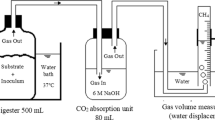Abstract
This study concerned the anaerobic treatment of five different industrial wastewaters with a diverse and complex chemical composition. The kinetics of biotransformation of this wastewater at different chemical oxygen demand (COD) were studied in a batch reactor. Wastewater from an amino acid producing industry (Fermex) and from a tank that received several types of wastewaters (collector) contained 0.83 g l−1 and 0.085 g l−1 sulfate, respectively. During the study period of 20 days, methane formation was observed in all types of wastewaters. Studies on COD biodegradation showed the reaction velocity was higher for Fermex wastewater and lower for collector wastewater, with values of 0.0022 h−1 and 0.0011 h−1, respectively. A lower methanogenic activity of 0.163 g CH4 day−1 g−1 volatile suspended solids (VSS) and 0.20 g CH4 day−1 g−1 VSS, respectively, was observed for paper producing and brewery wastewater. Adapted granular sludge showed the best biodegradation of COD during the 20-day period. The sulfate-reducing activity in pharmaceutical and collector wastewater was studied. A positive effect of sulfate-reducing activity on methanogenic activity was noted for both types of wastewaters, both of which contained sulfate ions. All reactions of methane generation for the tested industrial wastewaters were first-order. The results of this study suggest that the tested wastewaters are amenable to anaerobic treatment.







Similar content being viewed by others
References
American Public Health Association, American Water Works Association, Water Environment Federation (1998) Standard methods for the examination of water and wastewater, 20th edn. APHA-AWWA-WEF, Washington, D.C.
Bilanovic D, Battistoni P, Cecchi F, Pavan P, Mata AJ (1999) Denitrification under high nitrate concentration and alternating anoxic conditions. Water Res 33:3311–3320
Bradley MP, Fernández M, Chapelle FH (1992) Carbon limitation of denitrification rates in an anaerobic groundwater system. Environ Sci Technol 26:2377–2381
Buitrón G, Melgoza RM, Jiménez L (2003) Pharmaceutical wastewater treatment using an anaerobic/aerobic sequencing batch biofilter. J Environ Sci Health A 38:2077–2088
Driessen W, Yspeert P (1999) Anaerobic treatment of low, medium and high strength effluent in the agro-industry. Water Sci Technol 40:221–228
Fdz-Polanco F, Fdz-Polanco M, Fernández N, Ureña MA, García PA, Villaverde S (2001) Simultaneous organic nitrogen and sulfate removal in an anaerobic GAC fluidized bed reactor. Water Sci Technol 44:15–22
Gulmez B, Ozturk I, Alp K, Arikan OA (2000) Common anaerobic treatability of pharmaceutical and yeast industry wastewater. Water Res 34:725–734
Hao X, Martinez J, Svoboda I (1996) Nitrogen removal from the leachate of SOLEPUR treated pig slurry. Eur Water Pollut Control 6:31–36
Hasselblad S, Hallin S (1998) Intermittent addition of external carbon to enhance denitrification in activated sludge. Water Sci Technol 37:227–233
Huang SJ, Jye HJ (1995) Influences of carbon source and C/N ratio on nitrate/nitrite denitrification and carbon breakthrough. Bioresour Technol 54:45–51
Kim DJ, Miyahara T, Noike T (1997) Effect of C/N ratio on the bioregeneration of biological activated carbon. Water Sci Technol 36:239–249
Lacorte S, Latorre A, Barceló D, Rigol A, Malmqvist A, Welander T (2003) Organic compounds in paper-mill process waters and effluents. Anal Chem 22:725–737
LaPara TM, Nakatsu CH, Pantea LM, Alleman JE (2001) Aerobic biological treatment of a Pharmaceutical wastewater: effect of temperature on COD removal and bacterial community development. Water Res 35:4417–4425
McCartney DM, Oleszkiewicz JA (1991) Sulfide inhibition of anaerobic degradation of lactate and acetate. Water Res 25:203–209
Mohan SV, Prakasham RS, Satyavathi B, Annapurna J, Ramakrishna SV (2001) Biotreatability studies of pharmaceutical wastewater using an anaerobic suspended film contact reactor. Water Sci Technol 43:271–276
Parkin GF, Lynch NA, Chien KW, Van KEL, Bhattacharya SK (1990) Interactions between sulfate reducers and methanogens fed acetate and propionate. Water Environ Res 62:780–788
Reis MAM, Almeida JS, Lemos PC, Carrondo MJT (1992) Effect of hydrogen sulfide on growth of sulfate reducing bacteria. Biotechnol Bioeng 40:593–600
Rintala J, Sanz JLM, Lettinga G (1991) Thermophilic anaerobic treatment of sulfate rich pulp and paper integrate process water. Water Sci Technol 24:149–160
Rodríguez MJ, Rodríguez GI, Pedraza FE, Balagurusamy N, Sosa SG, Garza GY (2002) Kinetics of anaerobic treatment of slaughterhouse wastewater in batch and upflow anaerobic sludge blanket reactor. Bioresour Technol 85:235–241
Salkinoja SM, Apajalahti J, Silakoski L, Hakulinen R (1984) Anaerobic fluidized bed for the purification of effluents from chemical and mechanical pulping. Biotechnol Adv 2:357–375
Saravanane R, Murthy DVS, Krishnaiah K (2000) Assessment of toxicity and anaerobic degradation of anti-osmotic drug based pharmaceutical effluent in an upflow anaerobic fluidized bed system. Global Nest 2:149–158
Talib AS, Jacobsen HT, Vollertsen J, Ujang Z (2002) Anoxic transformations of wastewater organic matter in sewers process kinetics, model concept and wastewater treatment potential. Water Sci Technol 45:53–60
Thompson, Swain J, Kay M, Forster CF (2001) The treatment of pulp and paper mill effluent: a review. Bioresour Technol 77:275–286
Vallero MVG, Hulshoff Pol LW, Lens PNL, Lettinga G (2002) Effect of high salinity on the fate of methanol during the start-up of thermophilic (55°C) sulfate reducing reactors. Water Sci Technol 45:121–126
Van Houten TR, Van der Spoel H, Van Aelst CA, Hulshoff Pol WL, Lettinga G (1996) Biological sulfate reduction using gas as energy and carbon source. Biotechnol Bioeng 50:136–144
Weijma J, Gubbels F, Hulshoff Pol WL, Stams MAJ, Lens PNL, Lettinga G (2002) Competition for H2 between sulfate reducers, methanogens and homoacetogens in a gas lift reactor. Water Sci Technol 45:75–80
Zhou MG, Fang PHH (1998) Competition between methanogenesis and sulfidogenesis in anaerobic wastewater treatment. Water Sci Technol 38:317–324
Acknowledgement
We thank the Consejo Nacional de Ciencia y Tecnología (CONACYT) for financial support.
Author information
Authors and Affiliations
Corresponding author
Rights and permissions
About this article
Cite this article
Rodríguez-Martínez, J., Martínez-Amador, S.Y. & Garza-García, Y. Comparative anaerobic treatment of wastewater from pharmaceutical, brewery, paper and amino acid producing industries. J IND MICROBIOL BIOTECHNOL 32, 691–696 (2005). https://doi.org/10.1007/s10295-005-0244-z
Received:
Accepted:
Published:
Issue Date:
DOI: https://doi.org/10.1007/s10295-005-0244-z




